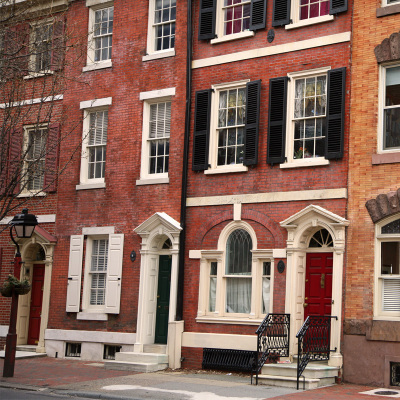Indoor Air Quality: Protecting the Future by Preserving the Past
 Older buildings are often constructed with hazardous building materials that require special management during preservation projects.
Older buildings are often constructed with hazardous building materials that require special management during preservation projects. This time of year an evening walk in one of the many downtown streets of Pennsylvania transports you to an era that is only recreated in the holiday classics. Our region is rich in historic buildings and places that allow us to reconnect with the past, places that remind us that Pennsylvania, and Philadelphia in particular was integral as the birth place of America. Historic places like the Valley Forge National Historical Park, Independence Hall in Philadelphia and its surrounding neighborhoods, and most of Gettysburg, and in many of the older towns and cities through out Pennsylvania, there are streets filled with historic rows homes, mansions and beautiful old brownstones that add more than a little charm to a community. Historic buildings help build a community’s character by connecting residents and visitors to the past.
Careful consideration must be given when these historic buildings are restored or renovated using modern methods and materials. Building materials of the past were built to stand the test of time; however, many of the materials contained ingredients we have come to know as significant health concerns due to various toxicities which were not understood at the time of construction. Ingredients such as asbestos, lead, mercury and PCB’s to name a few, were used because they were durable, inexpensive and effective at the job they were intended to perform. Typical applications for these materials included use as reinforcing agents, stabilizers, fillers, fireproofing, and pigments. What they did not know then, was that these materials (asbestos, lead, mercury, PCBs and others), created Indoor Air Quality (IAQ) issues and health hazards as they deteriorate or when they are removed during the renovation/reconstruction process.
Asbestos containing materials are commonly found in older buildings because asbestos, a natural occurring mineral fiber is an excellent insulator with a resistance to high temperatures. It is not electrically conductive and is useful as an additive to other materials as a filler and a re-enforcing fiber. Asbestos can be found in numerous materials including, but not limited to window and door caulking, wiring and pipe insulation, ceiling or wall plaster, tile and sheet floor covering and roofing materials. Asbestos which has been freed from its product, primarily impacts the respiratory system when it is released into the air. The hazards of exposure to asbestos are well known today and specific precautions have been developed which must be followed as asbestos containing materials are mitigated to avoid exposure during renovations or demolition.
Lead was used in paints to speed up drying, increase durability, maintain a fresh appearance, and resist moisture that causes corrosion. Lead based paints were commonly used in historic buildings until 1978 when it was banned from use in residential construction. However it is still present on many of those old buildings in the many layers of old paint. Lead, an environmental pollutant that is poisonous to humans, can be ingested or inhaled when lead is present in dust and paint chips that are created during normal wear and tear. For example lead based paint and varnishes found on doors, frames and jams, windows and cabinets can release paint as dust when the doors and windows are opened and closed on a regular basis releasing dust from the abrasion where moving parts rub. This dust may then be breathed in by occupants or settle on horizontal surfaces (the floor, counters, window sills, etc.) where occupant contact can result in ingestion, usually through poor hygiene.
Cadmium, Tin, Arsenic, Mercury and more Lead are also found in old wall paper. The mercury may off gas (release as vapor) and the other metals and additional mercury can be released in dust from normal wear and tear.
Polychlorinated biphenyls (PCBs), a toxic organic pollutant, was widely used as a coolant in transformers, capacitors and in old elevator motor switching systems due to its heat resistance, low volatility and non-electrical conductance and as a long life plasticizer in window and door frame caulking (plasticizers help keep materials flexible). PCBs are also found in fluorescent light ballast and some older electrical wire fittings.
These materials must be managed correctly to avoid the harmful health impacts associated with each material as the restoration process progresses. At Element Environmental Solutions, we highly recommend that a hazardous material inspection be conducted prior to building renovations (especially in older buildings) and that an Indoor Air Quality (IAQ) Management Plan be implemented as construction takes place. Restoring a historic building to its original form is a rewarding task that has a number of challenges. Careful handling of materials and planning is necessary to protect the health of workers and building occupants while preserving the historical character of the building. Once the hazardous materials are safely removed further care must be given to energy improvements as older buildings were designed to let air move freely through. Sealing the buildings envelope can create moisture issues that we’ll discuss in a later post. The challenges of restoring historic buildings may seem daunting at first, but the benefits are far reaching. Preserving historic buildings by managing hazardous materials appropriately assists with protecting the occupants and the public’s health, building a strong sense of place for your community and participating in the ultimate form of recycling, Land Recycling. By properly mitigating threats from the past we are building a brighter future.
To learn more about IAQ issues that can be found in historic buildings, please contact us.